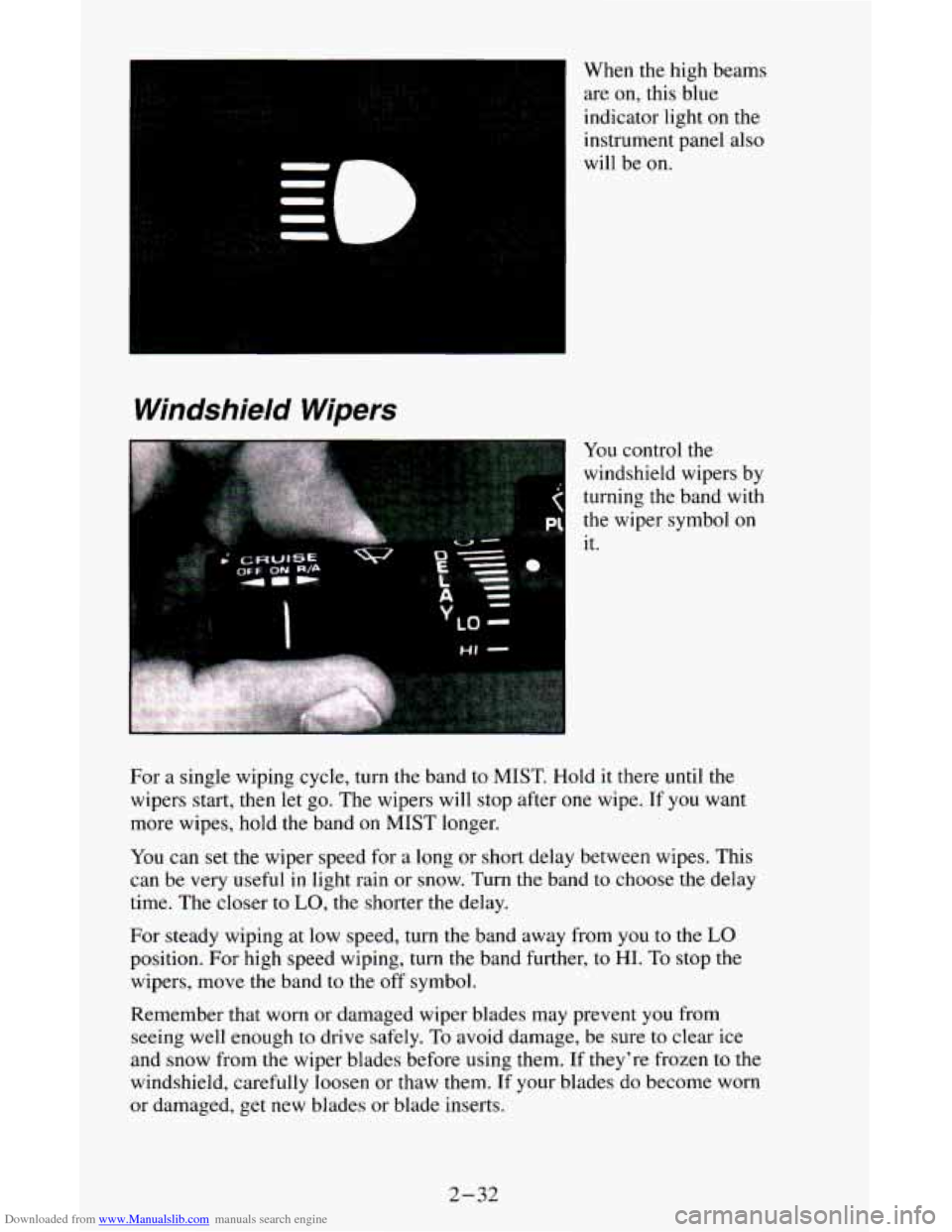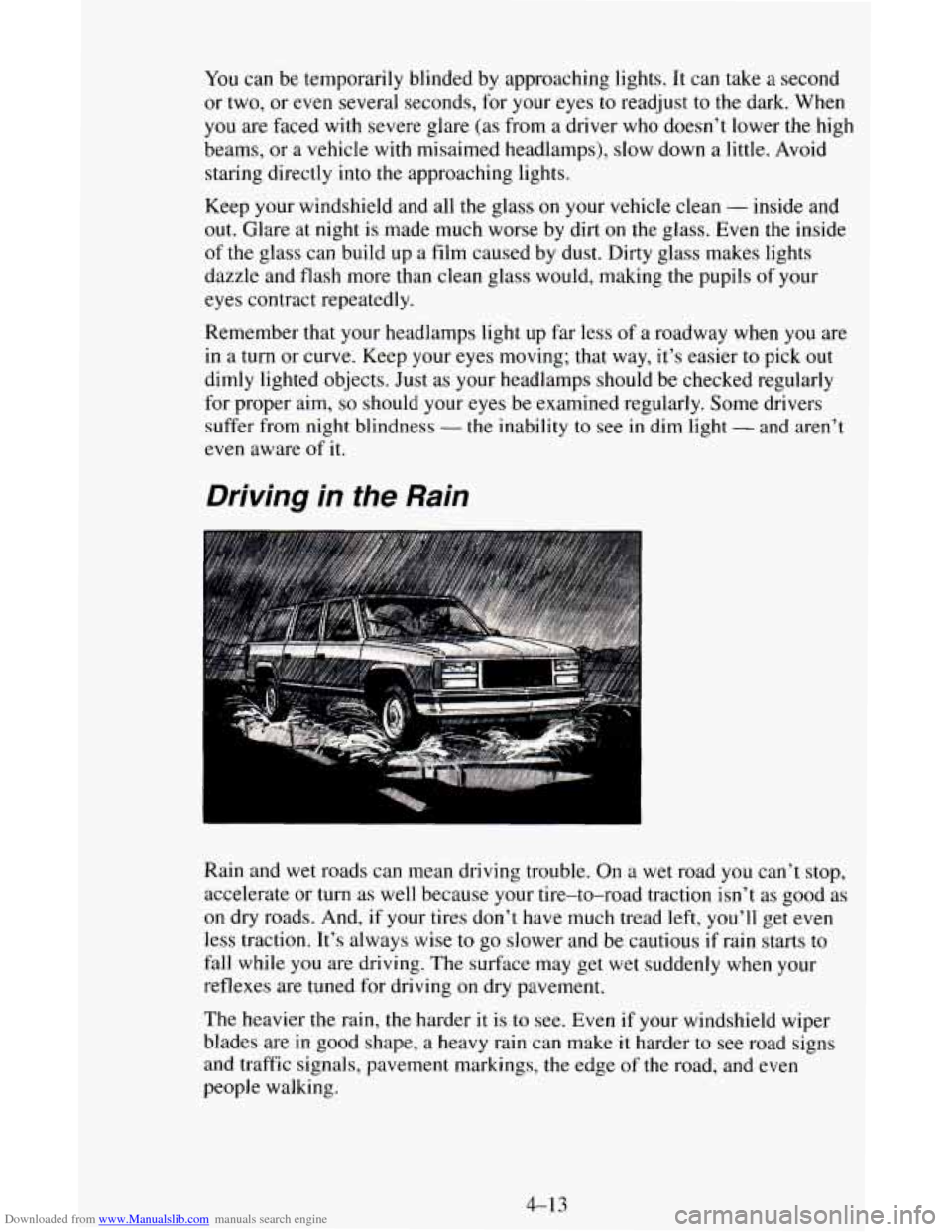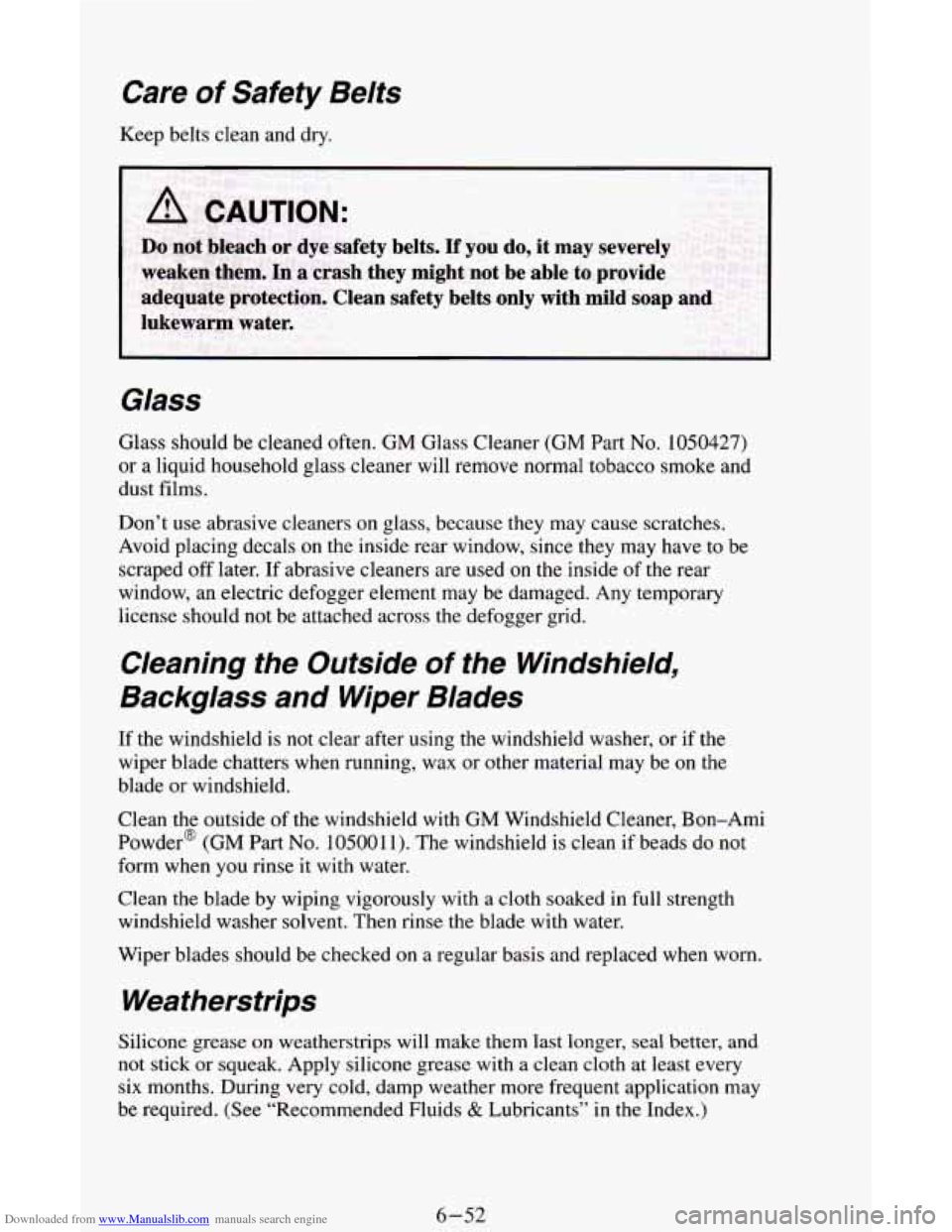1995 CHEVROLET ASTRO CARGO VAN wiper blades
[x] Cancel search: wiper bladesPage 86 of 342

Downloaded from www.Manualslib.com manuals search engine When the high beams
are on, this blue
indicator light
on the
instrument panel also
Windshield Wipers
I will be on.
You control the
windshield wipers by
turning the band with
the wiper symbol on
it.
For a single wiping cycle, turn the band to MIST. Hold it there until the
wipers start, then let go. The wipers will stop after one wipe. If
you want
more wipes, hold the band
on MIST longer.
You can set the wiper speed for a long
or short delay between wipes. This
can be very useful in light rain or snow. Turn
the band to choose the delay
time. The closer to
LO, the shorter the delay.
For steady wiping at low speed, turn the band away from
you to the LO
position. For high speed wiping, turn the band further, to HI. To stop the
wipers, move the band
to the off symbol.
Remember that worn or damaged wiper blades may prevent you from
seeing well enough
to drive safely. To avoid damage, be sure to clear ice
and snow from the wiper blades before using them. If they're frozen to the
windshield, carefully loosen
or thaw them. If your blades do become worn
or damaged, get new blades or blade inserts.
2-32
Page 151 of 342

Downloaded from www.Manualslib.com manuals search engine You can be temporarily blinded by approaching lights. It can take a second
or two, or even several seconds, for your eyes
to readjust to the dark. When
you are faced with severe glare (as from a driver who doesn’t lower the high
beams, or a vehicle with misaimed headlamps), slow down a little. Avoid
staring directly into
the approaching lights.
Keep your windshield and all the glass
on your vehicle clean - inside and
out. Glare at night is made much worse by dirt on the glass. Even the inside
of the glass can build up a film caused by dust. Dirty glass makes lights
dazzle and flash more than clean glass would, making the pupils
of your
eyes contract repeatedly.
Remember that your headlamps light up far less
of a roadway when you are
in a turn or curve. Keep your eyes moving; that way, it’s easier to pick out
dimly lighted objects. Just as your headlamps should be checked regularly
for proper aim,
so should your eyes be examined regularly. Some drivers
suffer from night blindness
- the inability to see in dim light - and aren’t
even aware of it.
Driving in the Rain
Rain and wet roads can mean driving trouble. On a wet road you can’t stop,
accelerate or turn as well because your tire-to-road traction
isn’t as good as
on dry roads. And, if your tires don’t have much tread left, you’ll get even
less traction. It’s always wise
to go slower and be cautious if rain starts to
fall while you are driving. The surface may get wet suddenly when your
reflexes are tuned
for driving on dry pavement.
The heavier the rain, the harder
it is to see. Even if your windshield wiper
blades are
in good shape, a heavy rain can make it harder to see road signs
and traffic signals, pavement markings, the edge
of the road, and even
people walking.
4-13
Page 155 of 342

Downloaded from www.Manualslib.com manuals search engine Before Leaving on a Long Trip
Make sure you’re ready. Try to be well rested. If you must start when you’re
not fresh
- such as after a day’s work - don’t plan to make too many
miles that first
part of the journey. Wear comfortable clothing and shoes you
can easily drive in.
Is your vehicle ready for a long trip?
If you keep it serviced and maintained,
it’s ready to go. If it needs service, have it done before starting out. Of
course, you’ll find experienced and able service experts in
GM dealerships
all across North America. They’ll be ready and willing to help if you need
it.
Here are some things you can check before a trip:
Windshield Washer Fluid: Is the reservoir full? Are all windows clean
inside and outside?
Wiper Blades: Are they in good shape?
0 Fuel, Engine Oil, Other Fluids: Have you checked all levels?
0 Lights: Are they all working? Are the lenses clean?
Tires: They are vitally important to a safe, trouble-free trip. Is the tread
good enough for long-distance driving? Are the tires all inflated to the
recommended pressure?
Should you delay your trip a short time to avoid a major storm system?
Weather Forecasts: What’s the weather outlook along your route?
Maps: Do you have up-to-date maps?
High way Hypnosis
Is there actually such a condition as “highway hypnosis”? Or is it just plain
falling asleep at the wheel? Call it highway hypnosis, lack
of awareness, or
whatever.
There is something about an easy stretch of road with the same scenery,
along with the hum
of the tires on the road, the drone of the engine, and the
rush of the wind against the vehicle that can make you sleepy. Don’t let it
happen to you! If it does, your vehicle can leave the road in
less than a
second, and you could crash and be injured.
What can you do about highway hypnosis? First, be aware that it can
happen.
4- 17
Page 260 of 342

Downloaded from www.Manualslib.com manuals search engine Care of Safety Belts
Keep belts clean and dry.
Glass
Glass should be cleaned often. GM Glass Cleaner (GM Part No. 1050427)
or a liquid household glass cleaner will remove normal tobacco smoke and
dust films.
Don’t use abrasive cleaners on glass, because
they may cause scratches.
Avoid placing decals on the inside rear window, since they may have to be
scraped
off later. If abrasive cleaners are used on the inside of the rear
window, an electric defogger element may be damaged. Any temporary
license should not be attached across the defogger grid.
Cleaning the Outside of the Windshield,
Backglass and Wiper Blades
If the windshield is not clear after using the windshield washer, or if the
wiper blade chatters when running, wax
or other material may be on the
blade or windshield.
Clean the outside
of the windshield with GM Windshield Cleaner, Bon-Ami
Powder@ (GM Part
No. 105001 1). The windshield is clean if beads do not
form when you rinse it with water.
Clean the blade by wiping vigorously with a cloth soaked in full strength
windshield washer solvent. Then rinse the blade with water.
Wiper blades should be checked on a regular basis and replaced when worn.
Weatherstrips
Silicone grease on weatherstrips will make them last longer, seal better, and
not stick or squeak. Apply silicone grease with a clean cloth at least every
six months. During very cold, damp weather more frequent application may
be required. (See “Recommended Fluids
& Lubricants’’ in the Index.)
6-52
Page 334 of 342

Downloaded from www.Manualslib.com manuals search engine Braking ......................................................... 4-5
In Emergencies
................................................ 4-7
Break-In, New Vehicle ........................................... 2-13
Bulb Replacement
Center High Mounted Stop Lamp (CHMSL)
........................ 6-39
Composite Headlamps
......................................... 6-35
Front Park Turn Signal Lamps
................................... 6-37
Halogen Bulb
................................................ 6-34
RearLamps
.................................................. 6-38
Replacement Chart
............................................ 6-63
Sealed Beam Headlamps
........................................ 6-33
C
Capacities and Specifications ....................................... 6-61
CarbonMonoxide
........................................... 2-254-30
Care of Your Cassette Tape Player (See “Audio Systems”
)
Cassette Tape Player System (See “Audio Systems’’ )
Catalytic Converter .............................................. 6-40
Center High Mounted Stop Lamp (CHMSL) (See “Bulb Replacement”
)
Certificationmire Label ........................................... 4-23
ChangingaFlatTire
.............................................. 5-21
Child Restraints (See “Safety Belts”)
Circuit Breakers (See “Fuses and Circuit Breakers”)
Cleaning Chemical Paint Spotting
........................................... 6-55
Cigarette LightedAshtrays
......................................... 2-46
Fabric Protection
.............................................. 6-50
Finishcare .................................................. 6-53
Glass
....................................................... 6-52
Insideofvehicle
.............................................. 6-49
Instrumentpanel. Top
.......................................... 6-51
OutsideofVehicle ............................................. 6-53
Outside
of the Windshield. Backglass and Wiper Blades ............... 6-52
Vinyl
....................................................... 6-51
WheelsandTires
.............................................. 6-54
AMRadio
.................................................... 3-6
Audio Systems
with AM/FM Stereo ................................ 3-6
Comfort Controls
................................................. 3-1
Compact Disc (CD) System (See “Audio Systems”)
Console Center Overhead
.............................................. 2-48
Control
of a Vehicle ............................................... 4-4
Coolant (See “Engine”)
Special Problems
.............................................. 6-50
Weatherstrips
................................................. 6-52
Clock, Setting the
Cooling System Capacity
.......................................... 6-62
Crankcase Capacity
.............................................. 6-62
Cruise Control
(Option) ........................................... 2-35
Passing Another Vehicle
........................................ 2-38
OnHills
..................................................... 2-38
ToGetOutOf
................................................ 2-39
ToEraseSpeedMemory
........................................ 2-39
ToIncreaseSpeed
............................................. 2-37
2